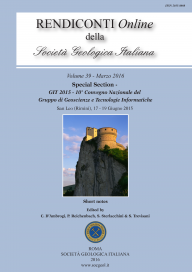
Automatic characterization of road networks under forest cover: advances in the analysis of roads and geomorphic process interaction
Giulia Sofia (a) & Paolo Tarolli (a)
(a) Department of Land, Environment, Agriculture and Forestry, University of Padova – Italy. E-mail: giulia.sofia@unipd.it
Volume: 39/2016
Pages: 23-26
Abstract
Mountain road networks support rural development, timber harvesting as well as local travel, trade, and tourism. However, roads represent a difficult and pressing environmental challenge because of their impacts on hydrogeomorphic processes in many locations around the world. For this reason, identifying the location and the structure of a road network is crucial. The position of the infrastructures relative to the valley floor and to ridges results in roads working as a sediment sources (inducing erosion/landslides) or sinks (acting as stopping/storage sites). Currently, the identification of roads and the analysis of their interaction with earth surface processes is based mostly on field surveys. To this point, this work tests an automatic approach to characterize the road network configuration (Sofia et al., 2016), and further extends its significance by analysing the interaction between the network morphology and geomorphic processes. The method considers LiDAR topography and specific topographic metrics that measure the homogeneity and the organization of the slope of a landscape (the Slope Local Length of Auto-Correlation –SLLAC, Sofia et al., 2014, and the derived average SLLAC and Surface Peak Curvature –Spc- per square kilometre). The Lookout Creek watershed (western Cascade Range, Oregon, USA) offers the ideal case study. The area is covered entirely by LiDAR topography; a database of roads and slides (debris flows, shallow and deep landslides) locations, including specific information on events connected to the roads, is available for the whole catchment. The results show how it is possible to automatically characterize the road network conformation also under vegetation cover. The procedure successfully detects areas presenting different shapes of the network, and it allows to deepen the analysis of the connection between the network structure and earth surface processes. To this point, given a similar geological domain and without denying the importance that the natural forcing has on geomorphic systems, networks created by short roads with sharp angles might be related to a greater surface instability, if compared to networks having similar densities, but longer roads and fewer road junctions. Further investigation on additional study cases is needed to confirm the effects of the road network configuration on surface processes, to substantiate the hypothesis that there is a connection between network morphology and surface instabilities. Nevertheless, the automatic characterization of road networks, especially under forest cover, represents a great opportunity to advance the science, while solving important environmental and planning problems.
Keywords
Get Full Text